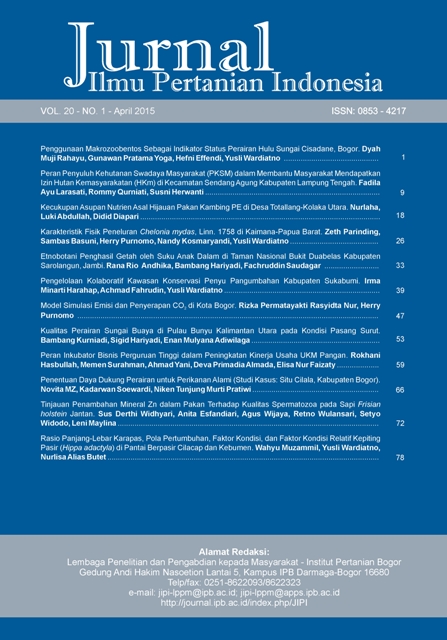Rasio Panjang-Lebar Karapas, Pola Pertumbuhan, Faktor Kondisi, dan Faktor Kondisi Relatif Kepiting Pasir (Hippa adactyla) di Pantai Berpasir Cilacap dan Kebumen
Abstract
Cilacap and Kebumen are potential coastal habitat for mole crab such as Hippa adactyla. Ecosystems condition of both locations is distinct. Each organism have to develop adaptation strategy to deal with environmental variation. H. adactyla usually burry into substrate to cope with environmental stress. They have been adapted to local habitat in order to be able for survive and reproduce. However, it has not been well known whether the adaptation strategy may vary the performance of morphology. This study focused on morphological variation of mole crab H. Adactyla. The sample was carried out on August 2014. Mole crabs were caught using traditional fishing gear called “sorok”. They were 118 individuals which where caught in Cilacap, while 102 individuals that were found in Kebumen. The result showed that H. adactyla walk vertically (backwards). These caused by carapace length and carapace width ratio. T-student analysis showed that relative growth for males were negatively allometric and isometric for female in both habitat. Mean of condition factor (K) for males in Cilacap was 0.0319 ± 0.0025 and 0.0315 ± 0.0028 in Kebumen. Those were significantly higher for females (p<0.05) in Cilacap (0.0325 ± 0.0050) and Kebumen (0.0329 ± 0.0027). Mean of relative condition factor (Kn) was higher in Cilacap for males and females. Those variations of K and Kn related to exogenous and endogenous factors.
Downloads
References
Amend M, Shanks A. 1999. Timing of Larval Release in the Mole Crab Emerita talpoida. Marine Ecology Progress Series. 183(1): 295-300.
Araujo MDSLC, Lira JJPR. 2012. Condition Factor and Carapace Width Versus Wet Weight Relationship in the Swimming Crab Callinectes danae Smith 1869 (Decapoda: Portunidae) at the Santa Cruz Channel, Pernambuco State, Brazil. Nauplius. 20(1): 41-50.
Blackweel BG, Brown ML, Willis DW. 2000. Relative Weight (Wr) Status and Current use in Fisheries
Assessment and Management. Reviews in Fisheries Science. 8(1): 1-44.
Boere V, Cansi ER, Alvarenga ABB, Silva IO. 2011. The Burying Behavior of the Mole Crab Before and After and Accident with Urban Sewage Effluents in Bombinhas Beach, Santa Catarina, Brazil. Ambi-Agua, Taubaté. 6(3): 70-76.
Boonruang P, Phasuk B. 1975. Species Composition and Abundance Distribution of Anomuran Sand Crabs and Population Bionomic of Emerita Emeritus (L) along The Indian Ocean Coast of Thailand (Decapoda: Hippidae). Phuket Marine Biological Center. Thailand. Research Bulletin. 8: 1-17.
Chan T-Y, Osawa M, Boyko CB, Ahyong ST, Macpherson E. 2010. Crustacean Fauna of Taiwan: Crab-Like Anomurans (Hippoidea, Lithodoidea, and Porcellanidae). National Taiwan Ocean University, Keelung (TW).
Defeo O, Gomez J, Lercari D. 2001. Testing the Swash Exclusion Hypothesis in Sandy Beach Populations: the Mole Crab Emerita brasiliensis in Uruguay. Marine Ecology Progress Series. 212(1): 159-170.
Dugan JE, Hubbard DM. 1996. Local Variation in Populations of the Sand Crab Emerita analoga on Sandy Beaches in Southern California. Revista Chilena de Historia Natural. 69(1): 579-588.
Effendie MI. 2002. Biologi Perikanan. Yayasan Pustaka Nusatama, Yogyakarta (ID).
Froese R. 2006. Cube Law, Condition Factor and Weight–Length Relationships: History, Meta-Analysis, and Recommendations. Journal of Applied Ichthyology. 22(1): 241-253.
Haye PA, Tam YK, Kornfield I. 2002. Molecular Phylogenetics of Mole Crabs (Hippidae: Emerita). Journal of Crustacean Biology. 22(4): 903-915.
Le Cren ED. 1951. The Length-Weight Relationship and Seasonal Cycle in Gonad Weight and Condition in the Perch (Perca fluviatilis). Journal of Animal Ecology. 20(2): 201-219.
Lercari D, Defeo O. 1999. Effect of Freshwater Discharge in Sandy Beach Populations: the Mole Crab Emerita brasiliensis in Uruguay. Estuarine, Coastal and Shelf Science. 49(1): 457-468.
Megawati E. 2012. Studi Beberapa Aspek Biologi Kepiting Pasir di Kecamatan Buluspesantren Kabupaten Kebumen. [Skripsi]. Bogor (ID): Institut Pertanian Bogor.
Murphy BR, Brown ML, Springer TA. 1991. The Relative Weight (Wr) Index in Fisheries Management: Status and Needs. Fisheries. 16(2): 30-38.
Mursyidin DH. 2007. Kandungan Asam Lemak Omega 6 Pada Ketam Pasir (Emerita spp.) di Pantai Selatan Yogyakarta. Bioscientiae. 4(2): 79-84.
Pinheiro MAA, Fiscarelli AG. 2009. Length-Weight Relationship and Condition Factor of the Mangrove Crab Ucides cordatus (Linnaeus, 1763) (Crustacea, Brachyura, Ucididae). Brazilian Archives of Biology and Technology. 52(2): 397-406.
Pinheiro MAA, Fransozo A. 1999. Reproduction of the Speckled Swimming Arenaeus cribrarius (Brachyura: Portunidae) on the Brazilian Coast Near 23°30’S. Journal of Crustacean Biology. 22(2): 416-428.
Powell CL, Ferdin ME, Busman M, Kvitek RG, Doucette GJ. 2002. Development of a Protocol for Determination of Domoic Acid in the Sand Crab (Emerita analoga): A Possible New Indicator Species. Toxicon. 40(1): 485-492.
Richter TJ. 2007. Development and Evaluation of Standard Weight Equations for Bridgelip Sucker and Largescale Sucker. North American Journal of Fisheries Management. 27(3): 936-939.
Schreiner JN. 2004. Adaptations by the Locomotor Systems of Terrestial and Amphibious Crabs Walking Freely on Land and Underwater. [Tesis]. United States of America (US): Louisiana State University.
Sleinis S, Silvey GE. 1980. Locomotion in a Forward Walking Crab. Journal of Comparative Physiology. 136(4): 301-312.
Veas R, Hernandez-Miranda E, Quinones RA. 2014. Body Shape and Burial Behavior of the Sand Crab Emerita analoga (Stimpson 1857) in a Reflective to Intermediate Morphodynamic Range of Sandy Beaches. Marine Biology. 161(10): 2345-2357.
Vidal-Gadea AG, Rinehart MD, Belanger JH. 2008. Skeletal Adaptations for Forwards and Sideways Walking in Three Species of Decapod Crustaceans. Arthropod Structure & Development. 37(2): 95-108.
Weissburg MJ, James CP, Smee DL, Webster DR. 2003. Fluid Mechanics Produces Conflicting, Constraints during Olfactory Navigation of the Blue Crabs, Callinectes sapidus. Journal of Experimental Biology. 206(1): 171-180.
This journal is published under the terms of the Creative Commons Attribution-NonCommercial 4.0 International License. Authors who publish with this journal agree to the following terms: Authors retain copyright and grant the journal right of first publication with the work simultaneously licensed under a Creative Commons Attribution-NonCommercial 4.0 International License. Attribution — You must give appropriate credit, provide a link to the license, and indicate if changes were made. You may do so in any reasonable manner, but not in any way that suggests the licensor endorses you or your use. NonCommercial — You may not use the material for commercial purposes.


















